Specifications TOYOTA RAV4 2012 XA30 / 3.G Owners Manual
[x] Cancel search | Manufacturer: TOYOTA, Model Year: 2012, Model line: RAV4, Model: TOYOTA RAV4 2012 XA30 / 3.GPages: 544, PDF Size: 10.25 MB
Page 1 of 544
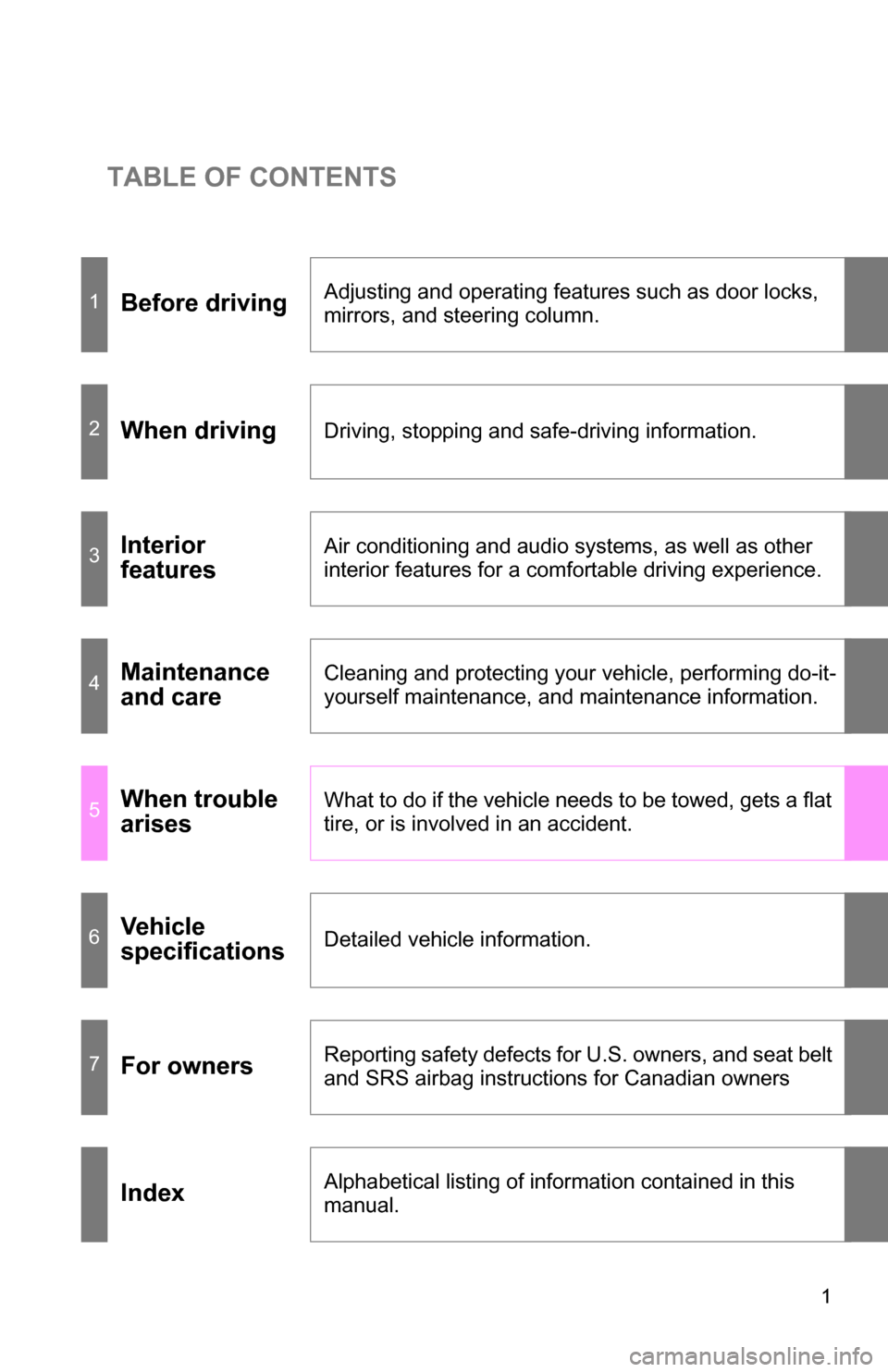
TABLE OF CONTENTS
1
1Before drivingAdjusting and operating features such as door locks,
mirrors, and steering column.
2When drivingDriving, stopping and safe-driving information.
3Interior
featuresAir conditioning and audio systems, as well as other
interior features for a comfortable driving experience.
4Maintenance
and careCleaning and protecting your vehicle, performing do-it-
yourself maintenance, and maintenance information.
5When trouble
arisesWhat to do if the vehicle needs to be towed, gets a flat
tire, or is involved in an accident.
6Vehicle
specificationsDetailed vehicle information.
7For ownersReporting safety defects for U.S. owners, and seat belt
and SRS airbag instructions for Canadian owners
IndexAlphabetical listing of information contained in this
manual.
Page 5 of 544
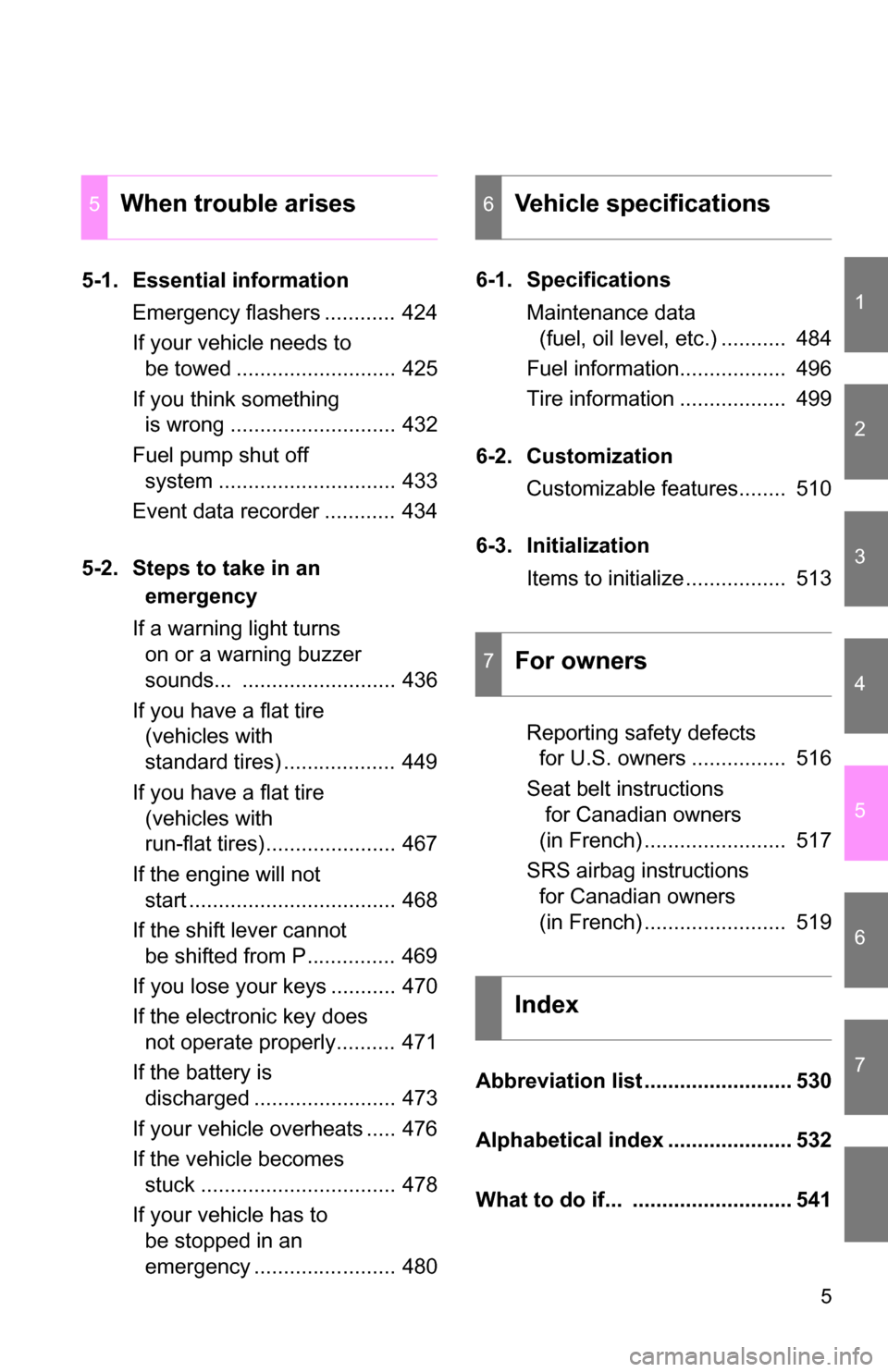
1
2
3
4
5
6
7
5
5-1. Essential informationEmergency flashers ............ 424
If your vehicle needs to be towed ........................... 425
If you think something is wrong ............................ 432
Fuel pump shut off system .............................. 433
Event data recorder ............ 434
5-2. Steps to take in an emergency
If a warning light turns on or a warning buzzer
sounds... .......................... 436
If you have a flat tire (vehicles with
standard tires) ................... 449
If you have a flat tire (vehicles with
run-flat tires)...................... 467
If the engine will not start ................................... 468
If the shift lever cannot be shifted from P............... 469
If you lose your keys ........... 470
If the electronic key does not operate properly.......... 471
If the battery is discharged ........................ 473
If your vehicle overheats ..... 476
If the vehicle becomes stuck ................................. 478
If your vehicle has to be stopped in an
emergency ........................ 480 6-1. Specifications
Maintenance data (fuel, oil level, etc.) ........... 484
Fuel information.................. 496
Tire information .................. 499
6-2. Customization Customizable features........ 510
6-3. Initialization Items to initialize ................. 513
Reporting safety defects for U.S. owners ................ 516
Seat belt instructions for Canadian owners
(in French) ........................ 517
SRS airbag instructions for Canadian owners
(in French) ........................ 519
Abbreviation list ......................... 530
Alphabetical index ..................... 532
What to do if... ........................... 541
5When trouble arises6Vehicle specifications
7For owners
Index
Page 18 of 544
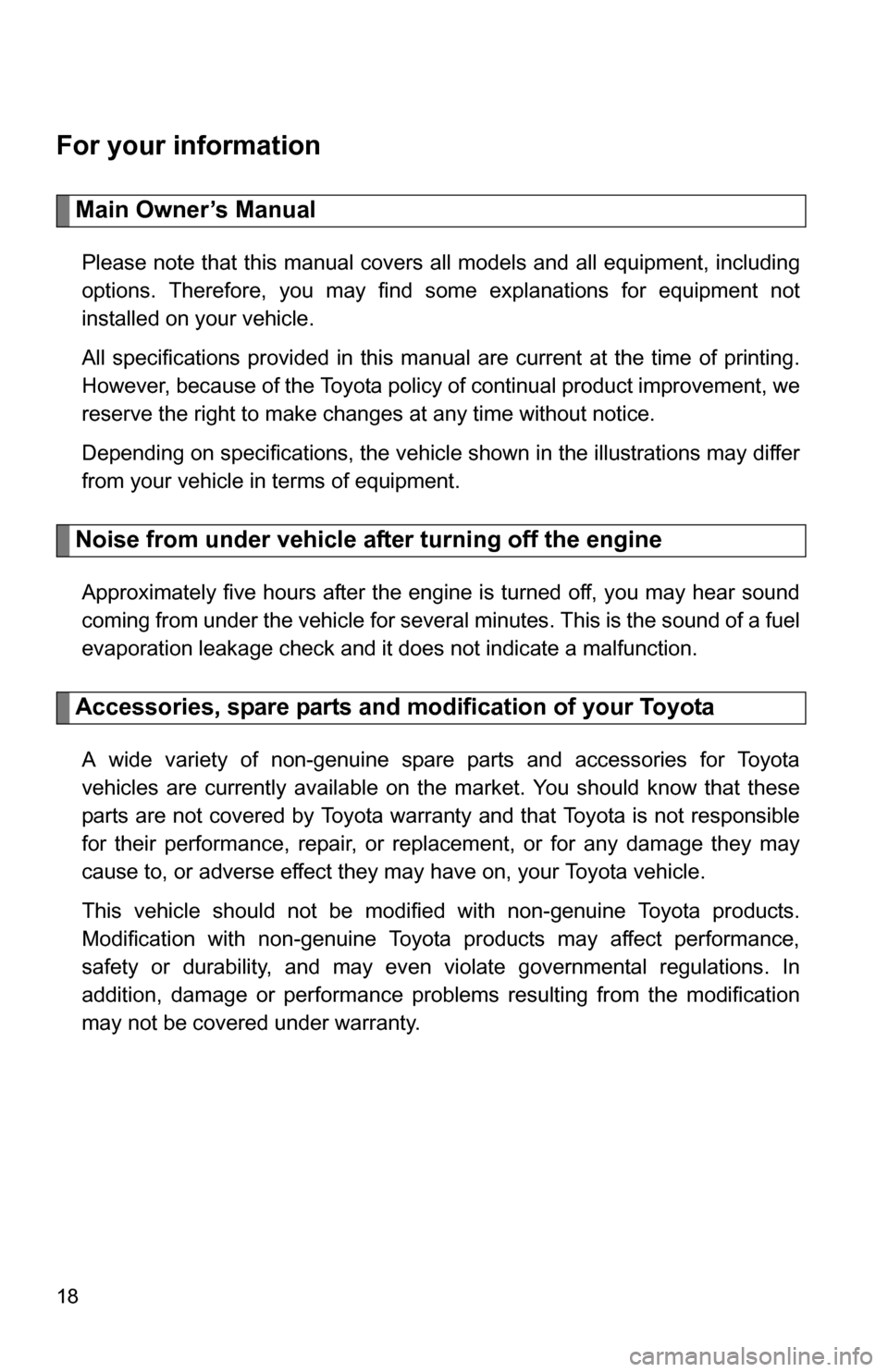
18
For your information
Main Owner’s Manual
Please note that this manual covers all models and all equipment, including
options. Therefore, you may find some explanations for equipment not
installed on your vehicle.
All specifications provided in this manual are current at the time of printing.
However, because of the Toyota policy of continual product improvement, we
reserve the right to make changes at any time without notice.
Depending on specifications, the vehicle shown in the illustrations may differ
from your vehicle in terms of equipment.
Noise from under vehicle after turning off the engine
Approximately five hours after the engine is turned off, you may hear sound
coming from under the vehicle for several minutes. This is the sound of a fuel
evaporation leakage check and it does not indicate a malfunction.
Accessories, spare parts and modification of your Toyota
A wide variety of non-genuine spare parts and accessories for Toyota
vehicles are currently available on the market. You should know that these
parts are not covered by Toyota warranty and that Toyota is not responsible
for their performance, repair, or replacement, or for any damage they may
cause to, or adverse effect they may have on, your Toyota vehicle.
This vehicle should not be modified with non-genuine Toyota products.
Modification with non-genuine Toyota products may affect performance,
safety or durability, and may even violate governmental regulations. In
addition, damage or performance problems resulting from the modification
may not be covered under warranty.
Page 483 of 544

Vehicle specifications6
483
6-1. SpecificationsMaintenance data (fuel, oil level, etc.) ......... 484
Fuel information ............... 496
Tire information ................ 499
6-2. Customization Customizable features ..... 510
6-3. Initialization Items to initialize .............. 513
Page 484 of 544

484
6-1. Specifications
Maintenance data (fuel, oil level, etc.)
Dimensions and weights
Overall length178.7 in. (4540 mm)*
1
180.7 in. (4590 mm)*2
180.9 in. (4595 mm)*3
181.1 in. (4600 mm)*4
181.9 in. (4620 mm)*5
Overall width
Without over fender
71.5 in. (1815 mm)
With over fender
73.0 in. (1855 mm)
Overall height*6
Without roof rails
66.3 in. (1685 mm)
66.5 in. (1690 mm)*
7
With roof rails
68.7 in. (1745 mm)
69.1 in. (1755 mm)*
7
Wheelbase
104.7 in. (2660 mm)
Front tread 61.4 in. (1560 mm)
61.8 in. (1570 mm)*4
Rear tread61.4 in. (1560 mm)
61.8 in. (1570 mm)*4
Vehicle capacity weight
(Occupants + luggage)825 lb. (370 kg)
1155 lb. (520 kg)*7
Page 485 of 544
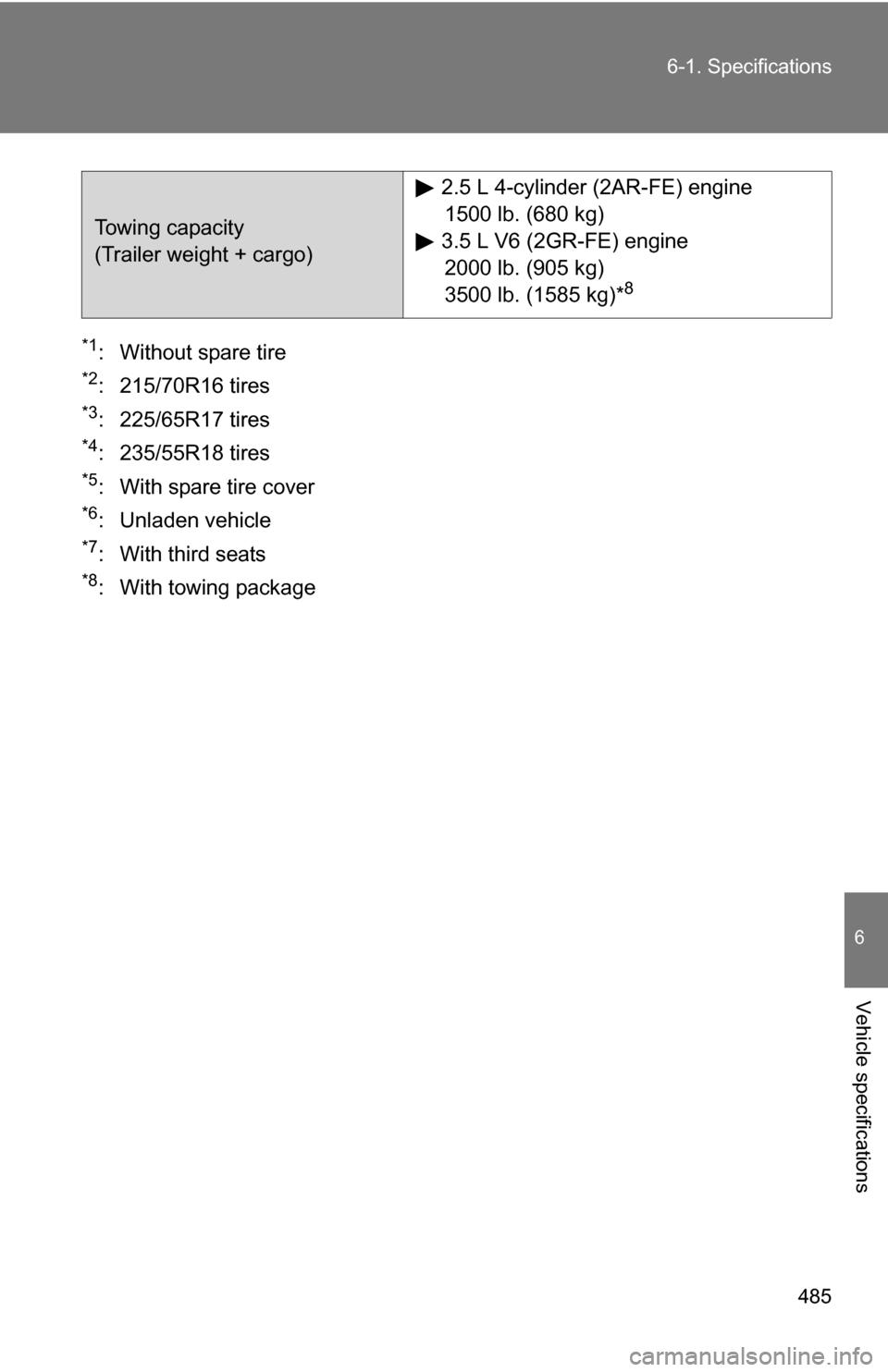
485
6-1. Specifications
6
Vehicle specifications
*1: Without spare tire
*2: 215/70R16 tires
*3: 225/65R17 tires
*4: 235/55R18 tires
*5: With spare tire cover
*6: Unladen vehicle
*7: With third seats
*8: With towing package
Towing capacity
(Trailer weight + cargo)
2.5 L 4-cylinder (2AR-FE) engine
1500 lb. (680 kg)
3.5 L V6 (2GR-FE) engine 2000 lb. (905 kg)
3500 lb. (1585 kg)*
8
Page 486 of 544

486 6-1. Specifications
Vehicle identification■ Vehicle identification number
The vehicle identificati on number (VIN) is the legal identifier for your
vehicle. This is the primary identification number for your Toyota. It is
used in registering the ownership of your vehicle.
This number is stamped on the
top left of the instrument panel.
On some models, this number is stamped under the front passen-
ger’s seat. This number is also on the Certi-
fication Label.
Page 487 of 544
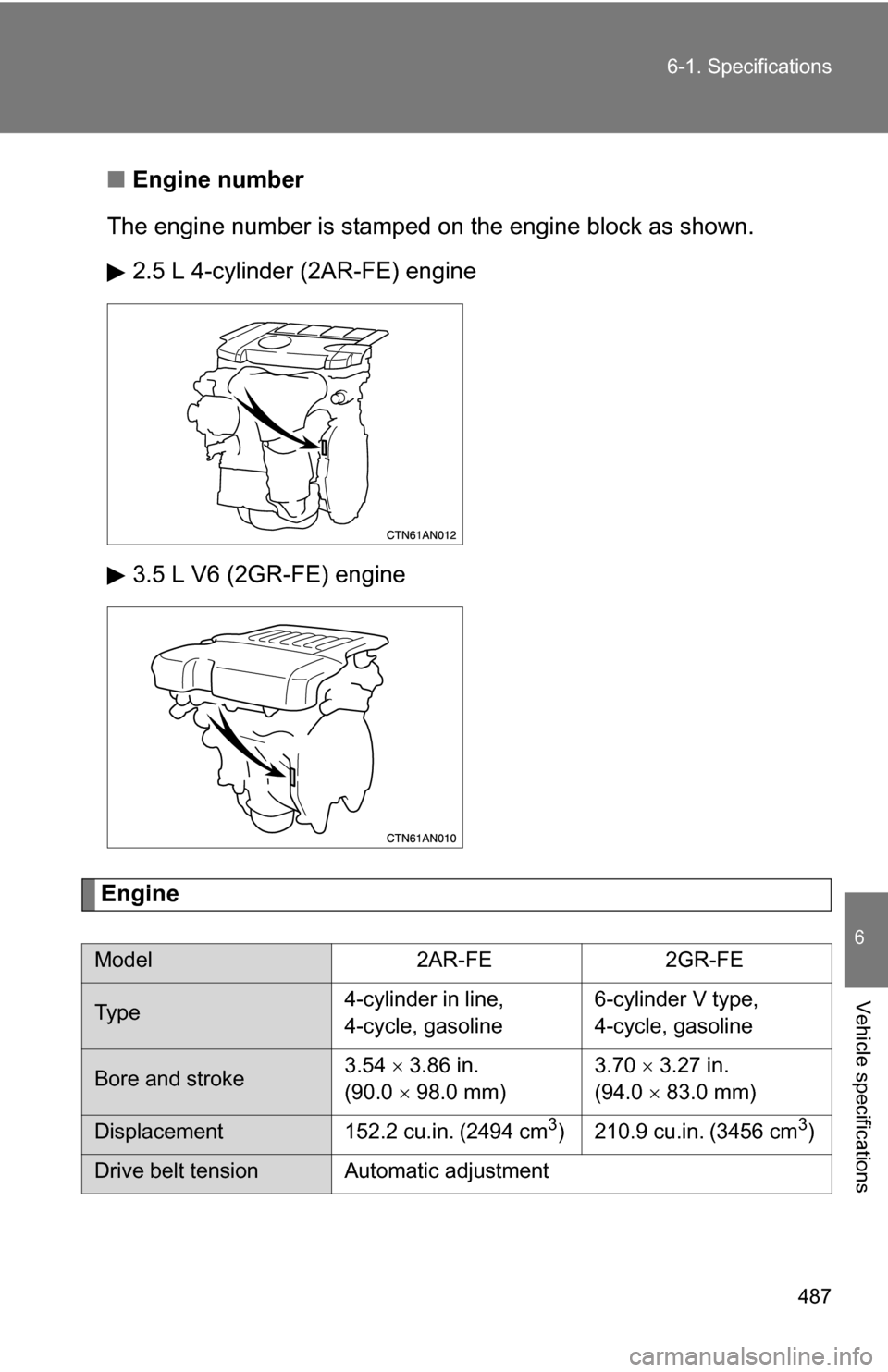
487
6-1. Specifications
6
Vehicle specifications
■
Engine number
The engine number is stamped on the engine bl ock as shown.
2.5 L 4-cylinder (2AR-FE) engine
3.5 L V6 (2GR-FE) engine
Engine
Model 2AR-FE2GR-FE
Ty p e 4-cylinder in line,
4-cycle, gasoline6-cylinder V type,
4-cycle, gasoline
Bore and stroke
3.54
3.86 in.
(90.0 98.0 mm) 3.70
3.27 in.
(94.0 83.0 mm)
Displacement 152.2 cu.in. (2494 cm3) 210.9 cu.in. (3456 cm3)
Drive belt tension Automatic adjustment
Page 488 of 544

488 6-1. Specifications
Fuel
Lubrication system
*: The engine oil capacity is a reference quantity to be used when exchanging.Warm up and turn off the engine, wait more than 5 minutes, and check the oil
level on the dipstick.
■Engine oil selection
“Toyota Genuine Motor Oil” is used in your Toyota vehicle. Use
Toyota approved “Toyota Genuine Motor Oil” or equivalent to satisfy
the following grade and viscosity.
Oil grade: ILSAC multigrade engine oil
Fuel type Unleaded gasoline only
Octane rating 87 (Research Octane Number 91) or higher
Fuel tank capacity
(Reference) 15.9 gal. (60 L, 13.2 Imp. gal.)
Oil capacity
(Drain and refill
reference*) Without filter
With filter 2.5 L 4-cylinder (2AR-FE) engine
4.2 qt. (4.0 L, 3.5 Imp. qt.)
3.5 L V6 (2GR-FE) engine
6.0 qt. (5.7 L, 5.0 Imp. qt.)
2.5 L 4-cylinder (2AR-FE) engine
4.7 qt. (4.4 L, 3.9 Imp. qt.)
3.5 L V6 (2GR-FE) engine
6.4 qt. (6.1 L, 5.4 Imp. qt.)
Page 489 of 544

489
6-1. Specifications
6
Vehicle specifications
Recommended viscosity:
2.5 L 4-cylinder (2AR-FE) engine
SAE 5W-20 or 0W-20
SAE 5W-20 or 0W-20 engine oil
may be used. However, SAE
0W-20 is the best choice for
good fuel economy and good
starting in cold weather.
Oil viscosity (0W-20 is explained here as an example):
●The 0W in 0W-20 indicates the characteristic of the oil which
allows cold startability. Oils with a lower value before the W allow
for easier starting of the engine in cold weather.
● The 20 in 0W-20 indicates the visc osity characteristic of the oil
when the oil is at high temperatur e. An oil with a higher viscosity
(one with a higher value) may be better suited if the vehicle is
operated at high speeds, or under extreme load conditions.
Outside temperature